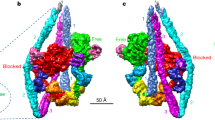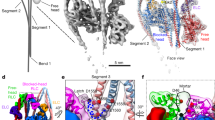Abstract
Steric blocking and unblocking1–3 of the myosin interaction sites in muscle thin filaments by tropomyosin provides a simple yet elegant method of regulating contraction in skeletal muscle. Recently, this model was challenged4 by the finding that tropomyosin is located on the opposite side of the thin filament helix axis from where Moore et al. reported that the myosin cross-bridge, S-1, bound5. However, new three-dimensional image reconstructions of electron micrographs of thin filaments decorated with S-1 were obtained by Taylor and Amos6, who proposed that the prior assignment of the S-1 binding site of Moore et al.5 was incorrect, and that consequently tropomyosin and S-1 are located on the same side of the actin helix. These past difficulties and the current lack of agreement7 on the location of the S-1 binding site suggested that another technique would be useful. We report here that the shape of S-1, derived from reconstructions using the Taylor and Amos actomyosin interpretation, gives a better fit to the X-ray scattering pattern observed from S-1 in solution than alternative interpretations.
This is a preview of subscription content, access via your institution
Access options
Subscribe to this journal
Receive 51 print issues and online access
$199.00 per year
only $3.90 per issue
Buy this article
- Purchase on Springer Link
- Instant access to full article PDF
Prices may be subject to local taxes which are calculated during checkout
Similar content being viewed by others
References
Haselgrove, J. C. Cold Spring Harb. Symp. quant. Biol. 37, 341–352 (1972).
Huxley, H. E. Cold Spring Harb. Symp. quant. Biol. 37, 361–376 (1972).
Parry, D. A. D. & Squire, J. J. molec. Biol. 75, 33–55 (1973).
Seymour, J. & O'Brien, E. J. Nature 283, 680–682 (1980).
Moore, P. B., Huxley, H. E. & De Roosier, D. J. J. molec. Biol. 50, 279–295 (1970).
Taylor, K. A. & Amos, L. J. molec. Biol. 147, 297–324 (1981).
Wakabayashi, T. & Toyoshima, C. J. Biochem. 90, 683–701 (1981).
Mendelson, R. A. & Kretzschmar, K. M. Biochemistry 19, 4103–4108 (1980).
Vibert, P. & Craig, R. J. molec. Biol. 157, 299–319 (1982).
Margossian, S. S., Lowey, S. & Barshop, B. Nature 258, 163–165 (1975).
Weeds, A. G. & Taylor, R. S. Nature 257, 54–56 (1975).
Margossian, S. S., Stafford, W. III & Lowey, S. Biochemistry 20, 2151–2155 (1981).
Craig, R. et al. J. molec. Biol. 140, 35–55 (1980).
Glatter, O. J. appl. Crystallogr. 10, 415–421 (1977).
Author information
Authors and Affiliations
Rights and permissions
About this article
Cite this article
Mendelson, R. X-ray scattering by myosin S-1: implications for the steric blocking model of muscle control. Nature 298, 665–667 (1982). https://doi.org/10.1038/298665a0
Received:
Accepted:
Issue Date:
DOI: https://doi.org/10.1038/298665a0
This article is cited by
-
Studies on the impellers generating force in muscle
Biophysical Reviews (2020)
-
Discrepancies in length of myosin head
Nature (1986)
-
Structure of myosin decorated actin filaments and natural thin filaments
Journal of Muscle Research and Cell Motility (1985)
-
Small-angle X-ray scattering from myosin heads in relaxed and rigor frog skeletal muscles
Nature (1983)
-
Structural evidence that myosin heads may interact with two sites on F-actin
Nature (1982)
Comments
By submitting a comment you agree to abide by our Terms and Community Guidelines. If you find something abusive or that does not comply with our terms or guidelines please flag it as inappropriate.



